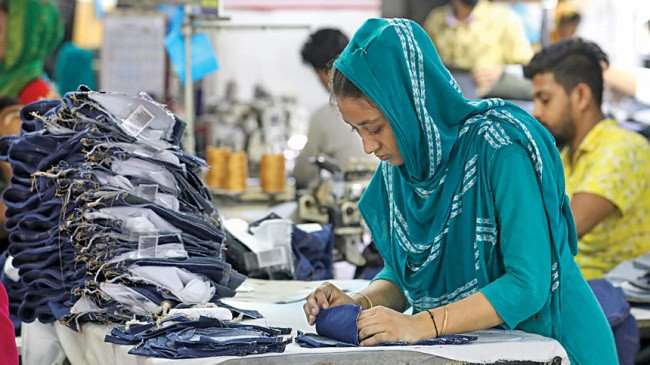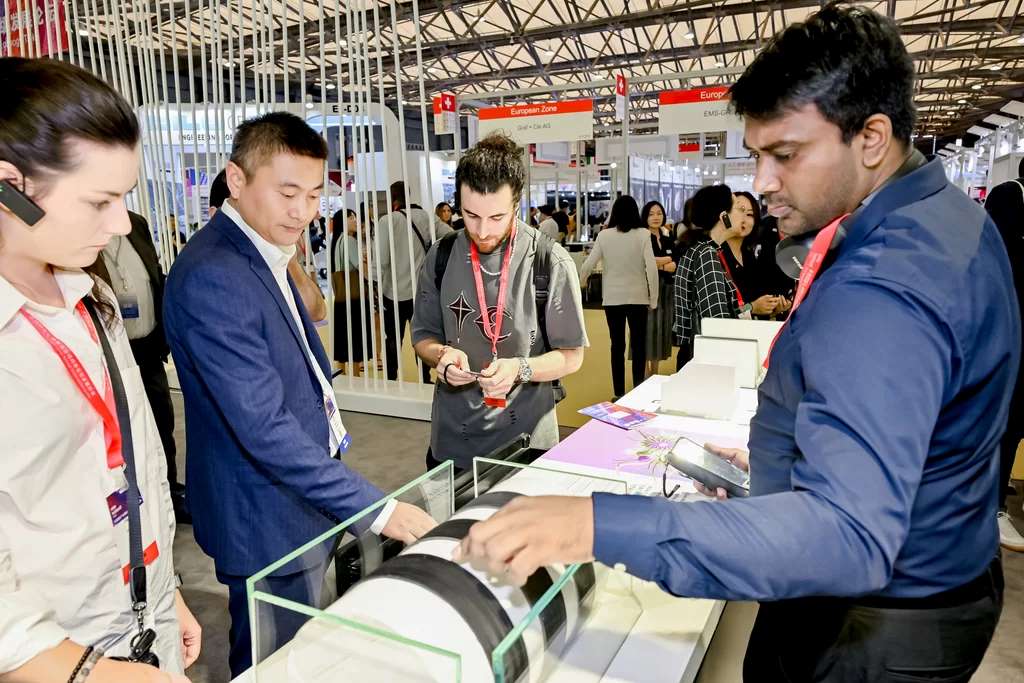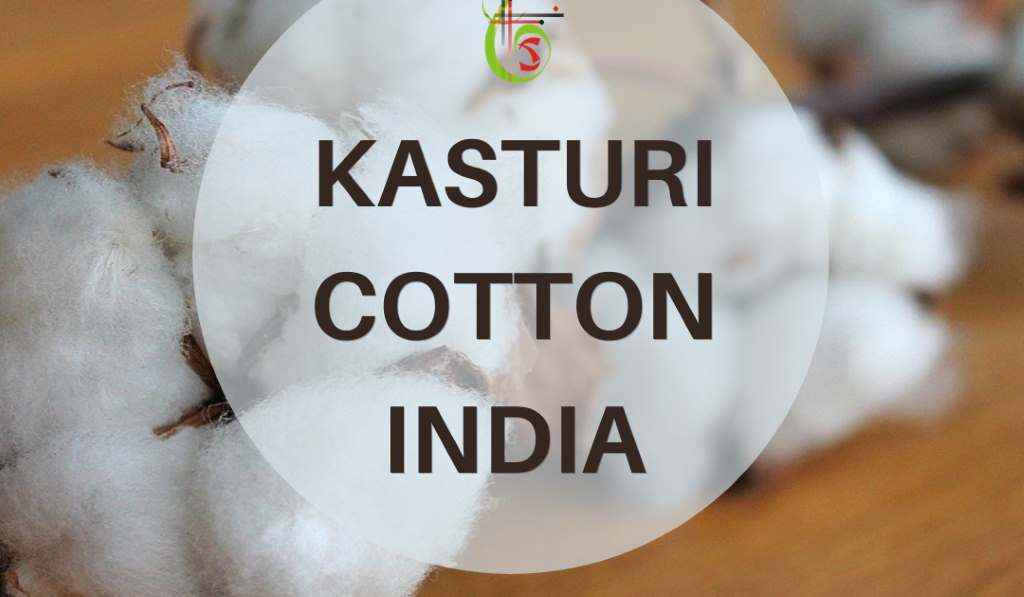FW
The Kingpins show was held in Amsterdam April 15 and 16. Amsterdam is increasingly becoming the denim capital of Europe. Much innovation and new developments were presented at the show disclosing denim novelties for Fall/Winter 2016-17. The new season had skinny fits for men as well as a slight return to denims that don’t employ stretch or employ it without looking like stretch fabrics. For women, flares were back as well as a more feminine version of the boyfriend cut that is tighter at the end and around the hips though always boxy and unisex.
Wintry looks and blends characterised many denim collections. Berto presented various melange effect denims, some employing a percentage of cashmere with selvedge. Denim Valley by Tejidos Royo presented various 100 per cent cotton denims with a woollen optic. Candiani Denim presented various soft touch melange denims that also employ nylon and tencel, though look like formal fabrics.
Orta presented its selection of cozy denims employing up to 20 per cent wool as well as a series of denims with a moleskin effect. Calik opted for a woolly aspect and uneven prints resembling wool surfaces. A series of micro designs and micro weaves were presented by ITV, Berto and Cone Denim. Cone is revamping its fabrics, including special ribbed-woven ones from the 1980s.
www.amsterdamdenimdays.com/kingpins-show-15-16-april/
Italian fashion retailer Benetton Group will double the amount of compensation paid to Rana Plaza Trust Fund. The retailer has been under pressure to increase its payment in the run-up to the second anniversary of the disaster, in which 1,138 workers died and thousands more were injured.
Benetton’s additional payment of $1.1 million adds to a previous payment of $5,00,000. It was one of 29 brands connected to companies operating in the Rana Plaza building.
Benetton was one of the first signatories of the Accord on Fire and Building Safety, which has improved factory safety in Bangladesh in the wake of the Rana Plaza disaster. Now, in addition to applying the Accord globally, the company plans to work with its suppliers to raise workers’ living standards.
The Rana Plaza building collapse in April 2013 shocked the world. There were stories of people amputating their own limbs in order to be freed from the rubble and survive. At least 29 global brands had orders with at least one of the five garment factories in the Rana Plaza building.
N Brown Group, VF Corporation and The Gap have also made contributions as brands who source from Bangladesh but have not had a sourcing relationship with Rana Plaza.
www.benetton.com/
Indian textiles suppliers, participating in a project to improve resource efficiency, cut chemical use in 2014 by 402 tons, says the Stockholm International Water Institute (Siwi). The project, called Sustainable Water Resources (Swar), involved Siwi, Swedish retail brands Indiska, KappAhl and Lindex, their Indian suppliers, the Swedish International Development Cooperation Agency (Sida) and India-based consultant cKinetics.
Over 40 factories from Delhi and Jaipur participated in the project, which involved providing technical consultations to factories to help them improve their chemical efficiency related to washing, dyeing, printing and water treatment. In the past two years, 13,000 factory workers and managers have been trained about how to reduce usage of chemicals in textile manufacturing like choice of materials, storage and handling, and awareness of international programs to phase out hazardous chemicals.
More than half the participating factories will continue to work on their own, continuously communicating their development to their clients in Sweden. Others have joined a network created by Siwi and the three fashion brands to continue education. The project will now expand to China, Turkey, Bangladesh and Ethiopia, while also including many other Indian states.
www.siwi.org
Brandix India Apparel City (BIAC) has partnered with four Chinese players to attract direct investment in home textiles in its facility located at Atchuthapuram mandal in the Vizag district. BIAC signed MoUs with Jiangsu Kingday Textile Co Limited, Zhejiang Hengyuan Chemical Fiber Group, Kunshan Rising Textile and Garment Co as well as Sumec Textile and Light Industry Co during CM N Chandrababu Naidu's visit to China to garner investments for the state.
Spread over1,000 acres, BIAC houses 10 manufacturing units, including UK-based Quantum Clothing, Ocean India, Seeds Intimate Apparel, Pioneer Elastics, Shore to Shore, Vardhman Yarns and Threads, International Trimmings and Labels, Ribest Ribbons and Bows (India), S&S Industries, Screenline Printing apart from three of its own units involved in manufacturing ladies underwear and T-shirts. BIAC also has also developed an effluent treatment plant with a capacity of treating 56 million litres of effluent discharge.
www.brandixapparelcity.com
Huntsman Textile has introduced Novacron XKS HD reactive ink for industrial ink jet printing. The ink achieves very deep shades as well as true black on multiple fibers. Huntsman is a provider of high quality dyes and chemicals to textile and related industries.
The ink is Kyocera-tested and compatible with Kyocera high-speed printer heads commonly used by printer manufacturers. The product delivers a high-performance result with minimal printer maintenance or downtime and minimizes ink waste. It also offers up to 50 per cent more color intensity than some other reactive inks available in the market. Its color-fastness makes it ideal for industrial digital printing of apparel and home textiles.
Industrial digital printing faces the challenge of delivering superior quality and optimum print reliability while effectively managing cost and environmental impact. Novacron addresses these demands and delivers the full effect of digital designs – intense, vivid colors and top quality finishing.
Novacron can be combined with Huntsman’s Prepajet Unitm pre-preparation auxiliary for exceptional color, printing efficiency and cost savings. The special polymer structure of the Prepajet auxiliary prevents ink migration on the fabric surface enabling optimum sharpness, definition and color intensity. It is easy to apply and remove and is suitable for use on all fibers.
www.huntsman.com/textile_effects/
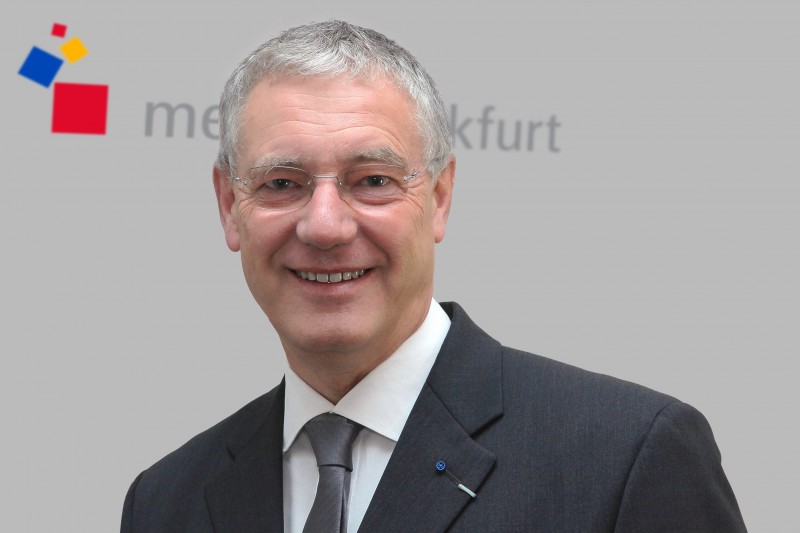
Finding signs of recovery in Spain and Portugal, Michael Scherpe, President of Messe Frankfurt, hopes to see the European economy getting better soon. Commenting on India’s prospect of generating interest in the European market, Scherpe says, “India can do much better as the country has good products in some ranges but has not capitalised on her strengths. In no way is India inferior to China or Turkey. Texworld and Apparelsourcing Paris can be the platforms. India needs to project herself and be present in many platforms. It is important to have visibility and an image.”
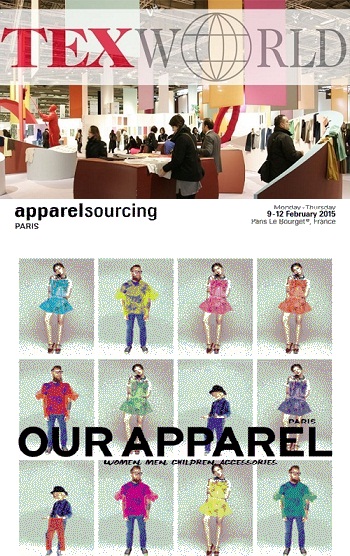
Throwing light on global sourcing scenario Scherpe says, “More and more countries will enter textile sourcing. Everyone knows Vietnam, Cambodia but Myanmar and Ethiopia are set to follow. Africa will assume importance in the next 10 years. Some of the countries will have more to do with their home market. Some countries like China will upgrade but to have more local market.”
Commenting on the slow growth of global consumption of textile, Scherpe feels, price is a problem. No one likes to pay more but it’s not possible to give discounts. “Buyers must realise that the minimum has been reached. It is also true of turnover. Every time you can’t grow 10 or 20 per cent. Growth will come in volumes. Volume of turnover is the other problem. This is a war between different product groups. If someone gives the customer a lower price he will take it. So retaining the customer is a problem,” he explains.
The Messe Frankfurt chief ruled out allegations that fashion industry has not been able to retain customers like other industries have done. He said, “Today customers are brand oriented and brands are concentrated in some companies. If I have a strong buying power I can keep the price down. It is a problem of concentration. There are a handful of brands, a problem of micro economy. The macro economy has to be organized to suit everyone.”
He believes European buying pattern has not changed. “Buyers have to consider the aspirations of European customers. They want sustainable products. They would like to give these at the same prices. At the moment there is something starting in Europe but it’s not strong enough. It is wrong to say Europe is sinking. People live better than in other regions. I think Asia has better living today than 30 years ago.” The European market is the most difficult market. It’s more demanding than the US.
An apparel and garment making centre is coming up at Arunachal Pradesh. This is part of a plan to have apparel and garment making centres in all Northeastern states. Work on such a centre has begun at Nagaland, Manipur and Sikkim.
Each apparel and garment making centre set up under the initiative is estimated to generate direct employment for 1,200 people. Each state will have a centre with three units, each having 100 machines. For local entrepreneurs with the requisite background, required facilities to start a unit will be provided in the plug and play mode. Once such entrepreneurs get established, they can set up their own units, allowing the facility to be provided to new entrepreneurs.
The initiative comes under the North East Region Textile Promotion Scheme (NERTPS) of the ministry of textiles. NERTPS is an umbrella scheme for the development of various segments of textiles i.e. silk, handlooms, handicrafts and apparels and garments. The scheme has a total outlay of Rs 1038 crores in the 12th Five Year Plan.
The project is beginning in the direction of setting up an organized textile industry in the north east. The estimated expense is Rs 18.18 crores for each state. Central assistance would be towards construction of physical infrastructure, purchase of machinery and capacity building for the next three years.
Garmon SpA, Italian textile chemical specialist, has launched a range of denim bleaching products that do not use permanganate, chlorine or any other halogenated chemicals for producing washed out or vintage looks in jeans. It is the first textile chemical company to have certain products certified to the ‘Greenscreen’ criteria developed by the US NGO ‘Clean Production Action’, the company also claimed.
Spraying fabrics with potassium permanganate reduces the risk of fibre damage to the cotton or other cellulosic fabrics used in denim and has become widespread. However, there is a potential for high concentrations of manganese (an essential micronutrient) to be released in the effluent, and in high concentrations this can be toxic.
Fabio Forti of Garmon said that a new, safer denim bleaching product has been launched because the use of permanganate to bleach denim is being scaled back by many large brands due to concerns about its environmental profile. ‘Avoloxy White’ denim bleaching system which is free of managanese, chlorine, iodine and bromine is presented to address this issue. It is safe to handle and produces high quality denim fabrics, he claimed.
The company is working closely with Turkish denim company Orta Anadolu, which supplies brands such as Gap, Levi Strauss and Uniqlo but Forti refused to say what the active ingredient of the new formula actually is. Garmon now has around 30 products certified to the Greenscreen criteria including enzyme treatments, resin finishes, softeners, pigments and auxiliaries such as its new ‘Avoloxy White’ denim bleaching system.
Greenscreen works with Nike to help its supply chain select safer chemical alternatives and the programme is also recommended by the Zero Discharge of Hazardous Chemicals Group (ZDHC) for substitution purposes.
Innerwear, and especially undergarments, as a product category is doing very well in Tirupur. There are hundreds of small scale stitching companies which undertake job work for domestic innerwear brands. More than 500 stitching units with around 30 tailors each are undertaking stitching and finishing work for domestic innerwear brands.
While most of Tirupur garment export units directly employ tailors, garment manufacturers who supply innerwear to the domestic market largely depend on small and medium stitching units on a job work basis.
Jupiter Knitting Company, Tirupur based an export is celebrating its golden jubilee in 2017. It makes briefs and has a total of 1,100 machines. It’s expecting at least 20 per cent growth this year. It exports most of its production to Europe.
On the other hand, six month old Kotan Apparels has just entered into vest and brief export. The company shipped orders to Saudi Arabia and is now exploring other markets. Right now Kotan is outsourcing the stitching process. Later it may start its own manufacturing. It is also targeting the domestic market with its brand Zyoke.
The Tanzania Cotton Board (TCB) is working on increasing value chains in the sector and empowering farmers to process cotton themselves in a bid to increase their revenues. Under the new system, cotton growers will reap the fruits of value addition. Currently ginners are the ones who enjoy the lion’s share of cotton profits making double income, because more than fiber they also earn from oil extracted from cotton seeds.
Ginners buy cotton seeds from farmers and they extract oil from cotton seeds and oilcake which they sell and obtain a lot of money compared to farmers. TCB is now working towards empowering farmers so that they can process their cotton and benefit from selling both cotton and its seeds.
The major markets for cotton from Tanzania are Indonesia, Thailand, India, China and Madagascar. The TCB has formed various associations in regions where the system is being implemented to simplify the process of obtaining loans and farm implements such as pesticides. It has launched a registration book for all farmers.
Cotton production levels are dwindling so much that several textile factories have stopped operations due to insufficient supplies. Farmers who are under the contract farming system have received financial support from Cotton Development Trust Fund.
www.cotton.or.tz/




